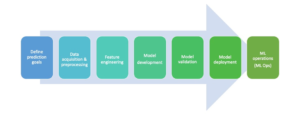What Every Intensivist Should Know About Using Data Science and AI in Prediction of Adverse Postoperative Events in the ICU
Utility of Predictive Analytics in Critical Care
Identifying the underlying cause of clinical deterioration in postoperative patients in the intensive care unit (ICU) can be difficult. AI can assist in identifying the root cause of clinical deterioration in postoperative patients in the ICU by predicting adverse events and providing a more precise diagnosis earlier and more accurately than human effort alone (1). Many clinical scenarios and ongoing research are now using AI-driven models that utilize the data readily available in the ICU to predict patient deterioration or adverse events, optimize treatment plans, and manage resources (2). The fundamental idea behind artificial intelligence (AI) is to enable computers to discover patterns within multi-domain and multidimensional data (3-4). The goal is to allow clinicians to intervene early and prevent adverse outcomes, such as cardiac arrest or sepsis (5-7).
What are the best data types and models for the prediction of postoperative outcomes in the ICU?
There are different data types and models used in prediction modeling, depending on the nature of the problem and the available data (4).
Data types:
Numerical data: This includes continuous or discrete numeric values, such as age, weight, and blood pressure.
Categorical data: This includes data that fall into categories, such as gender, race, or medical conditions.
Time-series data: This includes data that are collected over time, such as hourly vital signs, waveform data, or daily lab results.
Text data: This includes data in the form of unstructured text, such as physician notes or patient history.
Models:
Regression models: These models are used for predicting continuous or discrete outcomes based on one or more predictor variables. Linear regression and logistic regression are common examples.
Classification models: These models are used for predicting categorical outcomes based on one or more predictor variables. Examples include decision trees, random forests, and support vector machines.
Time-series models: These models are used for predicting future values in a time-series based on historical data. Examples include autoregressive integrated moving average (ARIMA) models and recurrent neural networks (RNNs).
Natural language processing (NLP) models: Processing and analyzing text data is a major function of NLP. Examples include various forms of Transformer models including Bidirectional Encoder Representations from Transformers (BERT).
The development of a model and implementation in a clinical workspace requires a series of steps to be executed (Figure 1). When selecting a model for prediction modeling, it is important to consider the nature of the data being analyzed and the research question being asked (8-10). Typically, the data preprocessing step after the data has been acquired, is one of the most resource-intensive steps. Preprocessed data can then be used for training and testing the selected prediction model. Each model has its strengths and weaknesses, and choosing the right approach can help ensure accurate and reliable predictions (11). Validation of the model, especially in an environment external to the model development data is important to address questions of bias, scalability, and generalizability. A validated model still requires implementation and translational steps to integrate the model output with the clinical decision-making interface, typically a device or the electronic health record. Methods for further maintenance of the models and monitoring of the model performance are important and continue to evolve.

Figure 1. Stepwise approach towards development and deployment of a machine learning prediction model
Predicting adverse events in ICU
AI can play an important role in predicting adverse events in the surgical ICU population by analyzing large amounts of patient data and identifying patterns and risk factors that may be difficult for human experts to identify (12). Some clinical examples where AI may be used to predict adverse postoperative events in the ICU:
Early warning systems: Early warning systems that detect changes in patient status may indicate a pending adverse event. These can monitor vital signs, laboratory results, and other data to identify patients who may be at risk. Adams et al, developed and prospectively validated a sepsis alert system built using physiological and laboratory data - the Targeted Real-time Early Warning System (TREWS), which has been shown to reduce in-hospital mortality (13).
Cluster analysis: Algorithms can be trained to analyze patient data and identify patterns that may indicate a higher risk of adverse events, so-called ‘pattern detection’. These algorithms can incorporate data from multiple sources, including patient history, comorbidities, and surgical factors, to predict the likelihood of complications (8).
Risk stratification: AI in the surgical ICU can be used to stratify patients into different risk categories based on their likelihood of experiencing adverse events. This can help intensivists prioritize care and allocate resources more effectively (14).
The overarching goal is to provide decision support to intensivists by providing real-time recommendations based on patient data (15). The final common ground would be based on a personalized medicine approach to develop treatment plans based on each patient’s unique characteristics and history. This can help reduce the risk of adverse events by tailoring treatment to each critically ill patient. These have already been implemented in the operating room, using tailored approaches for intraoperative hypotension.
Challenges with prediction modeling
There are several challenges associated with prediction modeling in the ICU. Some of the major challenges include the complexity and heterogeneity of patient data. ICU data can be complex and often incomplete, with missing data and variability in data quality, making it challenging to develop accurate prediction models. The lack of standardization of data can affect the accuracy and generalizability of prediction models. Additionally, the interpretation and communication of model predictions to clinicians can pose a challenge, as can the ethical considerations, including bias, surrounding the use of predictive analytics in critical care.
Predicting the future in the AI-guided ICU
Overall, the role of AI in predicting adverse postoperative events in the ICU is to provide intensivists with tools and insights that can help them identify patients at risk and take appropriate actions to prevent complications. As intensivists, we can improve patient outcomes and reduce the risk of adverse events, by using AI to help us in the ICU. However, AI development and implementation currently encounter several challenges in the ICU. Data quality is one of the most important variables affecting the predictive value of any AI model. To successfully implement AI into clinical practice, collaborative research efforts are required, along with plans for data standardization and plans to ensure data security and quality control. It's important to remember that AI is only a tool, and AI-guided healthcare is not about replacing human expertise, but rather about augmenting it. Ultimately, the vision for the future of AI-guided ICU is one in which AI is used to enhance the capabilities of intensivists, providing them with powerful decision-making tools that can help them provide better care to patients. As AI technology continues to advance, we can expect it to become an increasingly important tool in the ICU.
Bibliography
- Mathis MR, Engoren MC, Williams AM, Biesterveld BE, Croteau AJ, Cai L, Kim RB, Liu G, Ward KR, Najarian K, Gryak J; BCIL Collaborators Group. Prediction of Postoperative Deterioration in Cardiac Surgery Patients Using Electronic Health Record and Physiologic Waveform Data. Anesthesiology. 2022 Nov 1;137(5):586-601. doi: 10.1097/ALN.0000000000004345. PMID: 35950802.
- Mathur, Piyush MD, FCCM*; Burns, Michael L. MD, PhD†. Artificial Intelligence in Critical Care. International Anesthesiology Clinics 57(2): p 89-102, Spring 2019.
- Sanchez-Pinto LN, Luo Y, Churpek MM. Big data, and data science in critical care. Chest.2018;154(5):1239-48.
- Obermeyer Z, Emanuel EJ. Predicting the future—big data, machine learning, and clinical medicine. N Engl J Med.2016;375(13):1216–9.
- Yoon JH, Mu L, Chen L, et al. Predicting tachycardia as a surrogate for instability in the intensive care unit. J Clin Monit Comput. 2019; 33:973–85.
- Nemati S, Holder A, Razmi F, Stanley MD, Clifford GD, Buchman TG. An interpretable machine learning model for accurate prediction of sepsis in the ICU. Crit Care Med. 2018; 46:547–53.
- Komorowski M, Celi LA, Badawi O, Gordon AC, Faisal AA. The artificial intelligence clinician learns optimal treatment strategies for sepsis in intensive care. Nat Med. 2018; 24:1716–20.
- Gambus P, Shafer SL. Artificial intelligence for everyone. Anesthesiology. 2018;128(3):431-3.
- Rajkomar A, Dean J, Kohane I. Machine learning in medicine. N Engl J Med 2019; 380: 1347–58.
- Topol EJ. High-performance medicine: the convergence of human and artificial intelligence. Nature Med 2019; 25: 44–56.
- Esteva A, Robicquet A, Ramsundar B, Kuleshov V, DePristo M, Chou K, et al. A guide to deep learning in healthcare. Nature Med 2019; 25: 24–9.
- Lee CK, Hofer I, Gabel E, Baldi P, Cannesson M. Development, and validation of a deep neural network model for prediction of postoperative in-hospital mortality. Anesthesiology. 2018;129(4):649–62.
- Adams, R., Henry, K.E., Sridharan, A., et al. Prospective, multi-site study of patient outcomes after implementation of the TREWS machine learning-based early warning system for sepsis. Nat Med 28, 1455–1460 (2022).
- Castela Forte, J., Yeshmagambetova, G., van der Grinten, M.L. et al. Identifying and characterizing high-risk clusters in a heterogeneous ICU population with deep embedded clustering. Sci Rep 11, 12109 (2021). https://doi.org/10.1038/s41598-021-91297-x
- Maheshwari K, Cywinski JB, Papay F, Khanna AK, Mathur P. Artificial Intelligence for Perioperative Medicine: Perioperative Intelligence. Anesth Analg. 2022 Feb 24.






































